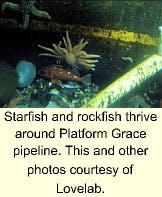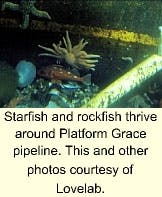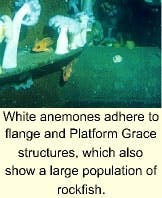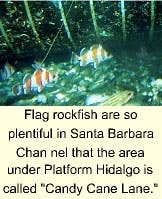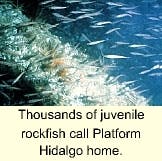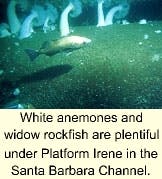California's old oil and gas facilities are no longer just for gathering dust and rust. They are now being eyed for a variety of creative uses.
In an ever-changing scenario, recent suggestions range from using offshore oil platforms as subsea medical research labs, prisons, artificial reefs for marine life, and surfing sites.
Onshore, proposals include using pipelines to carry sewage, transforming a marine terminal into a fiber optic landing site, establishing wildlife preserves, research into restoring contaminated sites, using a closed hazardous materials dump for a new onshore processing plant, and sites for resorts, homes, and golf courses.
The most immediate plan is a multimillion dollar study for medical research under eight Santa Barbara Channel oil platforms in a search for potential medicines that range from anticancer to anti-inflammation agents.
The US Minerals Management Service is funding the studies for the University of California at Santa Barbara and Louisiana State University. The MMS is providing each university with $500,000, which is being matched by the universities under a joint association called the Coastal Marine Institute (CMI).
"Marine biotechnology is a rapidly growing field," said David Hayes, Deputy Secretary of the Interior. "It is no secret that, like the rainforests, the oceans harbor life forms with untold potential for commercial and pharmaceutical uses."
The project will not disturb natural reef systems, according to Russell Schmitt, project coordinator at UCSB, because divers already scrape platform legs to reduce drag from ocean currents, throwing away more than 50 kinds of organisms. "It could be a gold mine or it could be a bust," Schmitt said. "Right now, they're bags of protoplasm, a hamburger for fish. But with this grant, we'll know a lot more."
Updates on the plethora of other uses for California oil facilities include:
- Rigs-to-reefs legislation by California State Senator Dede Alpert could get a huge boost from CMI's platform research projects. But for now, the legislation is inactive, put on hold until the next session.
Last year, the bill won approval from Senate and Assembly committees, but was put on hold. Sen. Alpert reintroduced the bill in early December and the issue is sure to be hotly contested again.
Although dozens of tapped-out platforms have been turned into reefs in the Gulf of Mexico, environmental groups in California strongly oppose the concept and have so far thwarted attempts at allowing old platforms to serve as reefs. Nevertheless, there is a long-term precedent due to 36 state-sanctioned artificial reefs off California, mostly in the state's southern section, but not from old oil platforms.
- Chevron Corp. has withdrawn the application to turn its Estero marine terminal near Morro Bay in San Luis Obispo County into a landing and control site for subsea fiber optic cable systems. Although the company "is still open to the idea," according to terminal manager Joe Gonzales, "we pulled our permit because we wanted to focus on decommissioning the facility."
Chevron closed the terminal last year after 70 years of operation, favoring a pipeline to move oil from the Bakersfield area to its Southern California refinery.
- Turning oil platforms into prisons after oil reserves are depleted may be "a little crazy," admitted Chevron's George Steinbach, but they could house 1,000 prisoners each and could meet the needs of the Bureau of Prison's proposal to build a new penitentiary in the Lompoc area situated in Santa Barbara County.
But David Dorworth, the bureau's chief of site selection, rejected it as "absolutely not an option."
"It's not practical...feasible...cost-effective [or] safe," he said, concluding "it would create more problems than it would solve."
That hasn't stopped Hollywood from using platforms as movie prisons or secret terrorist bases in a number of films over the years, however.
- Using two of Tosco Refining Co.'s oil pipelines for a new sewage system in Pismo Beach was rejected by the city because "significant corrosion could occur," explained city manager Michael Fuson.
Also, the city would be responsible for an expensive restoration after leasing the lines, and the area needs new sewage capacity now. Tosco is currently conducting a study on the future use of the pipelines, but won't be done with it for about a year.
- Santa Barbara County is studying 40 recommendations that would change policies for numerous oil and gas abandonment projects. Of 20 existing offshore platforms, primarily in the Santa Barbara Channel, several are expected to reach the end of their economic lives in the next 15 years.
The county takes a neutral position on converting rigs to reefs; it wants more research. If conversion to a reef is not beneficial, then the entire removal is favored. Leaving shell mounds built up under the rigs is also an issue left for more research, but recycling rigs and harvesting marine growth for fertilizers is favored.
- A large portion-2,333 acres-of the Guadalupe-Nipomo Dunes in San Luis Obispo County is already a wildlife preserve, known as the Mobil Coastal Preserve and now owned by the nonprofit Nature Conservancy. However, the land in San Luis Obispo County may become a National Wildlife Refuge and it's possible a larger area containing the Guadalupe oil field will be added.
The Guadalupe Dunes area is undergoing a massive clean-up of leaked diluent by Unocal Corp. (OGJ, May 24, 1999, p. 33), and the US Fish and Wildlife Service won't consider it for refuge status unless guarantees are made that the federal government wouldn't get involved in the clean-up.
Meanwhile, the Guadalupe Dunes has become a living laboratory, with Unocal donating $5.6 million to California Polytechnic Institute for research into how best to clean up petroleum product spills that could have worldwide applications. So far, CalPoly researchers are improving bioremediation techniques by enhancing the rate that natural bacteria break down petroleum.
- Carpinteria, Calif., has ideas that the land now containing Venoco Inc.'s oil and gas plant could be transformed into a resort, research and development center, or golf course if abandoned in 5 years. Venoco, however, disputes the city's environmental analysis, asserting it intends to operate the facility for another 20 years.
- The California Coastal Commission ordered Chevron to pay for an artificial reef to create surfing waves off of El Segundo. The Surfrider Foundation said a jetty built by Chevron destroyed the reef.
- Perhaps the most likely use for old oil properties is what Ross Brunetti of the California Oil and Gas Division calls "surface development," or the construction of homes, stores, roads, and parks. Brunetti noted that Unocal, Texaco Inc., and others are selling off their onshore lands on the Central Coast area, even in the face of recent oil price hikes, because the fields are depleted.
